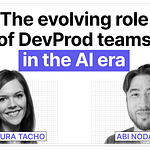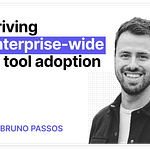Listen and watch now on YouTube, Apple, and Spotify.
Jesse Adametz is a Senior Engineering Leader on the Developer Platform at Twilio, where he’s leading a multi-year effort to unify tech stacks across major acquisitions. I’m joined by him today to talk about the realities of platform adoption and migration, the challenges of Kubernetes, and why mandates don’t work when you’re bringing together strong engineering cultures. We also dive into why Jesse treats developer experience as a product, what “change as a service” looks like in practice, and how Twilio is approaching AI with pragmatism, experimentation, and a focus on real value.
Some takeaways:
Platform adoption and migrations
Consolidation is multi-year and non-linear. Twilio’s integration of Segment, SendGrid, and core stacks showed that platform consolidation is never a straight path. Early decisions, like launching EKS in Europe first for data residency before migrating U.S. workloads, highlight the inevitable “zigzags.”
Migrations are about people as much as tech. Developers won’t abandon working systems on command. Advocacy, training, and executive alignment are critical — Jesse points to a past effort to put all engineers on call that only worked with CEO buy-in and steady rollout.
Balance greenfield and brownfield. Twilio puts new services onto golden paths such as standardized Java pipelines, while gradually remediating older, bespoke setups. Greenfield adoption refines the standards that brownfield teams follow once value is proven.
Carrots work better than mandates. Scorecards and contextual quality checks nudge teams toward best practices, while hard stops are reserved for critical reliability or security gaps.
Developer experience as a product
Treat platforms like products. Twilio surveys developers, tracks NPS, and requires alpha customers before building new tools. If no teams are ready to test, platform focuses on paying down tech debt instead.
Centralize the cost of change. Rather than hundreds of teams repeating the same migrations, platform absorbs the toil, standardizing and automating on-ramps so engineers get smoother adoption paths.
Change as a service reduces pain. The long-term goal is pre-tested PRs with confidence scores, making migrations as simple as review and merge. This requires standardized tests, frameworks, and rollback strategies to scale safely.
Show value early and often. Developers move when they see clear improvements. Dashboards highlight service quality gains and consolidated metrics roll into leadership reviews to reinforce progress across levels.
Kubernetes and modernization
Kubernetes isn’t always the answer. While it solved many problems, Twilio’s telephony and SIP workloads didn’t fit neatly. Forcing Kubernetes everywhere would have created more pain than value.
Modernization is the bigger picture. Twilio emphasizes improvements like autoscaling groups, observability, and simplifying legacy systems rather than betting on a single orchestrator.
Unify the developer experience. A consistent experience across stacks matters more than enforcing a single tool. Developers should interact with one UX regardless of what’s running underneath.
Reveal complexity only when needed. Golden paths hide infrastructure details for most engineers, with advanced controls surfaced only for high-scale, internet-facing workloads.
AI adoption
AI hype feels different from Kubernetes. Kubernetes shifted work sideways, but AI promises to remove repetitive tasks and elevate workflows. Adoption requires structured experiments, benchmarks, and cultural adaptation.
AI is both art and science. Clear PRDs and strong prompting skills dramatically improve AI outputs, and platform teams should train developers in these practices.
AI changes workflows, not just tools. Engineers spend less time writing code and more time reviewing it, requiring higher throughput and different habits.
Experimentation and standardization must coexist. Twilio’s review boards enforce safety and vendor discipline while greenfield teams run short feedback loops to test new tools.
Guilds expose platform gaps. The AI DevEx guild drew 400 members instantly, showing demand for shared learning. Over time, platform should absorb this role instead of leaving it to grassroots groups.
AI can augment incidents, not replace engineers. Vendors promising self-healing agents are overhyped, but AI already helps with anomaly detection and other narrow, reliable applications.
Tool evaluation and reliability
Pricing should encourage healthy behavior. Per-run or per-policy models discourage usage and visibility. Twilio favors per-seat or platform-level pricing that scales with engineering needs.
Reliability is non-negotiable. As an infrastructure provider, Twilio demands “dial-tone” reliability from its vendors, weighing monitoring, availability, and scale just as heavily as price.
Support as a platform capability
Internal developers deserve customer-grade support. Today’s fragmented Slack channels create noise; a single entry point ensures clarity and visibility.
Support requests reveal automation opportunities. Analyzing tickets showed that automating just two processes could reduce requests by double digits.
A single “oh button” sets the standard. One clear way to ask for help, backed by automation and human fallback, gives developers the same reliability expected in customer support.
In this episode, we cover:
(00:00) Intro
(01:30) Jesse’s background and how he ended up at Twilio
(04:00) What SRE teaches leaders and ICs
(06:06) Where Twilio started the post-acquisition integration
(08:22) Why platform migrations can’t follow a straight-line plan
(10:05) How Twilio balances multiple strategies for migrations
(12:30) The human side of change: advocacy, training, and alignment
(17:46) Treating developer experience as a first-class product
(21:40) What “change as a service” looks like in practice
(24:57) A mandateless approach: creating voluntary adoption through value
(28:50) How Twilio demonstrates value with metrics and reviews
(30:41) Why Kubernetes wasn’t the right fit for all Twilio workloads
(36:12) How Twilio decides when to expose complexity
(38:23) Lessons from Kubernetes hype and how AI demands more experimentation
(44:48) Where AI fits into Twilio’s platform strategy
(49:45) How guilds fill needs the platform team hasn’t yet met
(51:17) The future of platform in centralizing knowledge and standards
(54:32) How Twilio evaluates tools for fit, pricing, and reliability
(57:53) Where Twilio applies AI in reliability, and where Jesse is skeptical
(59:26) Laura’s vibe-coded side project built on Twilio
(1:01:11) How external lessons shape Twilio’s approach to platform support and docs
Where to find Jesse Adametz:
• LinkedIn: https://www.linkedin.com/in/jesseadametz/
• X: https://x.com/jesseadametz
• Website: https://www.jesseadametz.com/
Where to find Laura Tacho:
• LinkedIn: https://www.linkedin.com/in/lauratacho/
• Website: https://lauratacho.com/
• Laura’s course (Measuring Engineering Performance and AI Impact) https://lauratacho.com/developer-productivity-metrics-course










